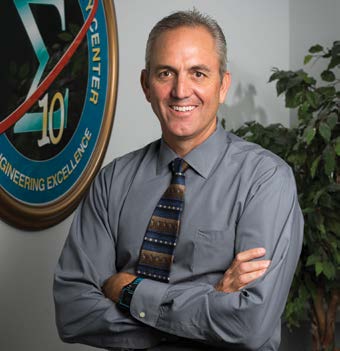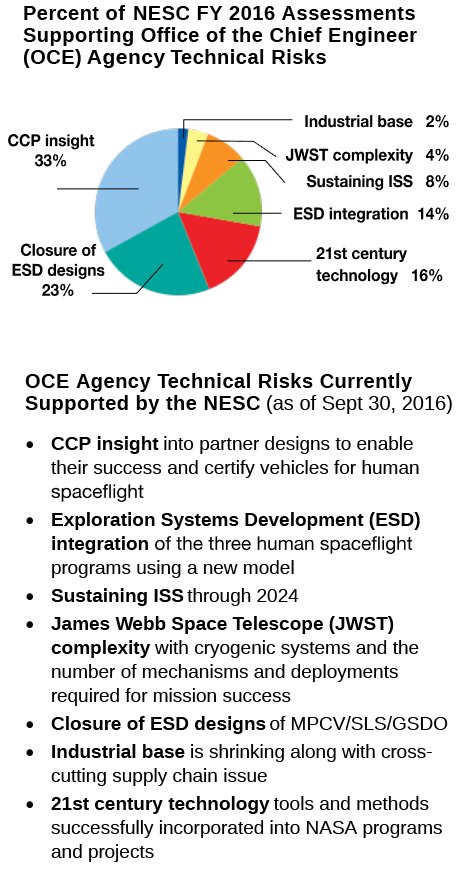How the NESC keeps its focus on key technical risks
As the NESC Deputy Director, Michael Kirsch is navigating the NESC’s technical portfolio through a rough fiscal climate — working within a fixed budget while juggling a constant influx of requests for the NESC’s technical expertise. In this Q&A, he explains the delicate balance required to weigh those budget constraints against which assessments will offer the best opportunities to mitigate NASA’s top technical risks.
You have held several positions at the NESC including Principal Engineer (PE), Manager of the Management and Technical Support Office (MTSO), and now Deputy Director. How have those positions prepared you to make decisions on what work the NESC will pursue?
As a PE, I led several independent technical assessments that included developing an independent Crew Exploration Vehicle (CEV) design, evaluating the use of carbon fiber composites on Orion’s crew module primary structure, fabricating a full-scale composite crew module (CCM), and contributing to an alternate design of the Orion heatshield carrier structure. Those projects put my technical background from White Sands to good use, but they also offered me the chance to hone my management skills. Each assessment involved bringing in experts from different NASA Centers, multiple disciplines, and technical backgrounds. I had to keep that team focused, adjust plans, and resolve issues as we progressed toward the project objective, all within a cost and schedule constraint.
And in every assessment, I made a conscious effort to find ways to manage the financial aspects. I developed tools and techniques to manage cost estimates and progress against actual cost and performance, which I later used as the MTSO Manager and Deputy Director to help manage the total NESC technical portfolio. So my technical background combined with that management experience has helped me prioritize and figure out how best to apply our NESC resources.
The NESC receives a continuous influx of requests from NASA programs and projects. How do you mesh such a dynamic workload with a fixed budget?
Fortunately, the demand for our support has exceeded our capacity, which is a great place to be, but it also requires you to make judgments on what work will have the biggest benefit for the Agency. During 2015 and 2016, we were starting the year almost fully encumbered. There were many times that, in order to take on higher priority work, we had to make some tough decisions to descope some of the work, reduce the amount of test or development work that we had originally planned, or defer certain work to the following year. In some cases we were able to negotiate partnerships with our stakeholders to share some of the expenses. For 2017, I have no doubt that early into the fiscal year (FY) we will be once again fully subscribed.
What is driving the increase in high priority work?
I believe the Agency may be as busy as it’s ever been in terms of transitioning development projects into qualification testing. The Orion Multi-Purpose Crew Vehicle (MPCV) Program, the Space Launch System (SLS) Program, Ground Systems Development and Operations (GSDO), and the Commercial Crew Program (CCP) are all going into the development and test phase of their life cycles. And it’s during development and test that many technical issues emerge. I think that’s where the NESC has contributed and will continue to have good opportunities to help those programs achieve their objectives. The overall demand on NESC expertise and support is going to be as high as it’s ever been. To me it’s analogous to the days of the Shuttle’s return to flight, but more so because it involves several programs.
From a broader NASA perspective, how is the NESC helping to mitigate the Agency’s top technical risks?
When former NESC Director Ralph Roe took the position of NASA Chief Engineer, he put emphasis on understanding what he considers to be the Agency’s top technical risks (on right). He spent time with the NASA’s engineering directors, chief engineers, and programs to identify those risks. That helped focus the engineering community on prioritizing workloads. At the NESC, we are also prioritizing and aligning our portfolio with those top technical risks to ensure we are contributing to their mitigation. The NESC was formed to help the Agency solve its toughest technical challenges. Some of those top risks aren’t in the NESC’s mission, such as maintaining a broad industrial base for critical spacecraft skills, but helping the SLS, Orion MPCV, or GSDO close on their designs within their cost schedule and mass constraints are areas where the NESC can help.
As Deputy Director, how has your perspective on the NESC changed since your days as a PE?
As a PE, I was very singularly focused on the objective associated with my particular task. It was about delivering an alternate design for the CEV or delivering a CCM. As the MTSO Manager and now as Deputy Director, I want to know about NASA’s exploration mission, science mission, or aeronautics mission. It’s a much broader check on whether our day-to-day role is helping the Agency achieve its mission. The challenges are much bigger than developing an alternate design for the Orion heatshield. Our NESC technical leads — the NASA Technical Fellows, the Principal Engineers, and the NESC Chief Engineers — maintain a sharp focus on the individual technical goals of their tasks, but from the NESC’s director’s office perspective, we’re trying to make sure the NESC portfolio is helping the Agency as a whole achieve its objectives.



























